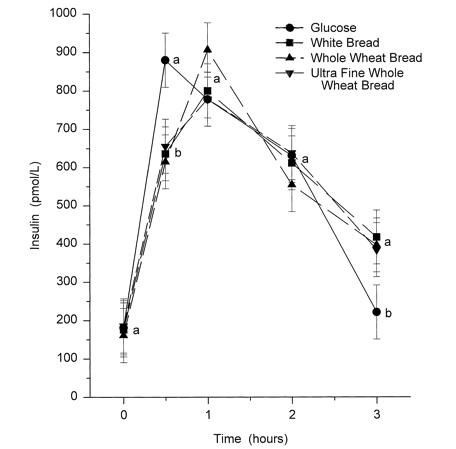High levels of insulin - "hyperinsulinemia" - is among the fundamental steps that lead to so-called resistance to insulin that, in turn, leads to the cascade of events resulting in visceral fat accumulation, i.e., deep abdominal fat that encircles organs and is a virtual factory for inflammatory signals. Foods that trigger insulin to high levels thereby can be expected to contribute most to growing that belly hanging over your belt.
Below is a graph of blood insulin responses after oral glucose, white bread, whole wheat bread, and bread made from a finely-ground flour that the investigators called "ultra-fine-ground whole-grain wheat flour." This was done by a group at the USDA to study whether the particle size of wheat made any difference on blood sugar, insulin, and other measures, but I think it demonstrates something different.
From Behall et al 1999. Full text here.
Note that all 4 challenge foods increased insulin approximately four-fold - 400%. That's an awful lot. But did you notice what food increased insulin the most? Yup, whole wheat bread, even without the fine-grind.
Eat wheat-containing grains for breakfast, lunch, dinner, and snacks and guess what? You'll have sky-high insulin levels triggered repeatedly throughout the day. Given a few years of day-in, day-out high insulin and you will grow this collection of visceral fat I call a "wheat belly."




Why are we still promoting that 55 - 65 percent of our energy consumption should com from carbohydrates?
What is the case against saturated fat?
[Link]